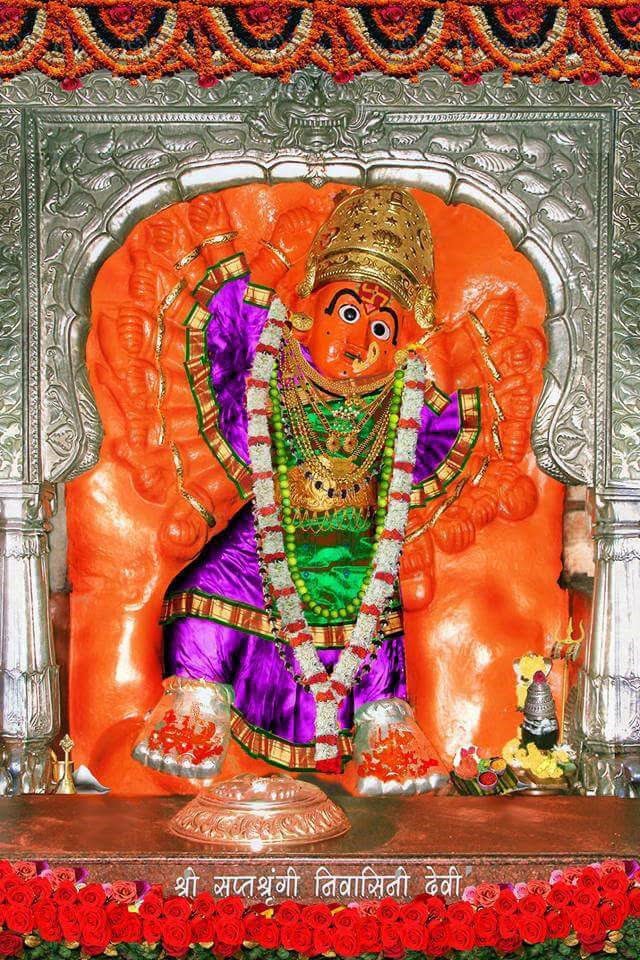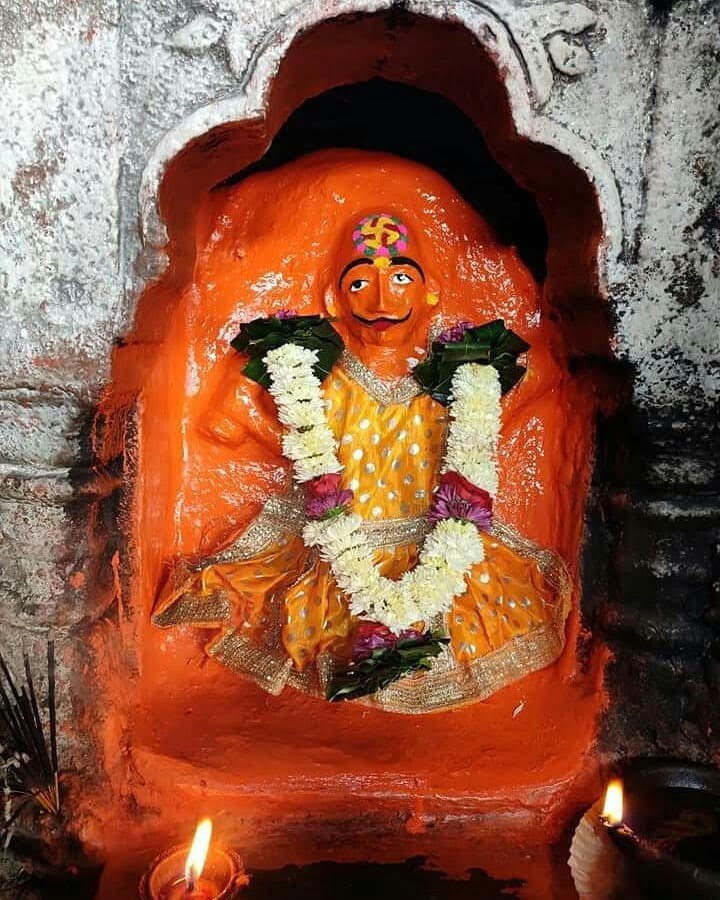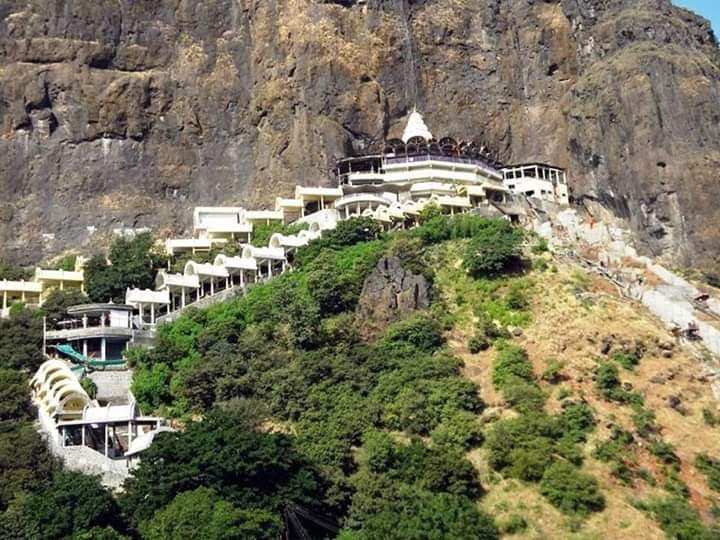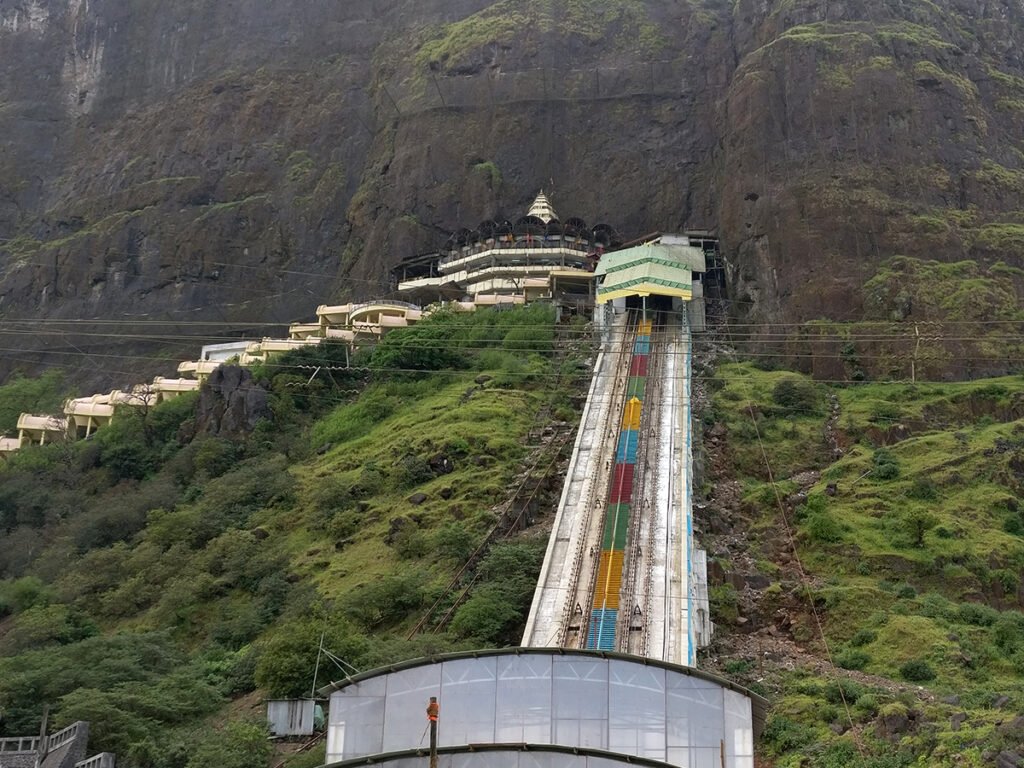Saptashrungi Bhadrakali Temple Nasik
Saptashrungi Bhadrakali Temple is one of the 51 Shakti Peeth located at Nasik, Maharashtra, India. Goddess is called different names like Bhramari, Chibuka (the one with the chin) and Saptashrungi (Goddess who has seven arms) lord Bhairava associated with a goddess is called with the name Vikritaksh or Sarvasiddhish (lord to fulfill all desires). Goddess is said to be swayambhu (self-manifested) who is 10 feet tall with 18 hands holding weapons.

Contents
- 1 Significance of Saptashrungi Temple:
- 2 History of Saptashrungi Temple:
- 3 Legend of Saptashrungi Temple:
- 4 Saptashrungi Temple Timing:
- 5 Rituals and Offerings at Saptashrungi Temple:
- 6 Places to visit near Saptashrungi Bhadrakali Temple:
- 7 FAQ:
- 7.0.1 Where is Saptashrungi Bhadrakali Temple located?
- 7.0.2 What is the significance of the Saptashrungi Bhadrakali Temple?
- 7.0.3 How do I reach Saptashrungi Bhadrakali Temple?
- 7.0.4 What is the best time to visit the Saptashrungi Bhadrakali Temple?
- 7.0.5 Is there an entry fee to the temple?
- 7.0.6 What are the temple’s opening hours?
- 7.0.7 Are there any specific dress code or guidelines for visitors?
- 7.0.8 Can non-Hindus visit the temple?
- 7.0.9 Are there facilities for food and accommodation near the temple?
- 7.0.10 Is photography allowed inside the temple?
- 8 How to reach Saptashrungi Bhadrakali Temple in Nasik:
- 9 Google Maps:
Significance of Saptashrungi Temple:
According to the mythology Daksha yagna and Sati self-immolation, it is the holy place where Sati Devi’s “Chin” fell down.
Devotees believe that Bhramari Devi is equivalent to a million dark suns as she is surrounded by black bees. Also, it is believed that the sound produced by black bees sounds like the beej mantra “Hring”. Because of her brilliant dark nature, she is also called Kalika or Bhadrakali who destroys egoistic demons.
There is another saying that the goddess created thousands of black bees to kill a demon named Aruna who was blessed by Lord Brahma not to be killed by any living creature that has legs, wings, weapons, etc. ignoring bees. In another belief, the goddess is called Mahishasur Mardini, the goddess who slew a demon named Mahishasur when he took the form of buffalo. Hence we can still find stone-made buffalo heads at the foot of the hill.
Goddess is always coated with sindhoor like Lord Hanuman which locals believe to be auspicious. She is dressed with precious ornaments made with a silver nose ring and gold items. As per ancient texts, Lord Rama along with goddess Sita came here to seek Bhramari Devi’s blessing.
Explore More>> Gandaki Shakti Peeth Muktinath Temple

History of Saptashrungi Temple:
The exact history of the Saptashrungi Bhadrakali Temple is unknown, but it is believed to be over 1,000 years old. The earliest mention of the temple is in the 12th century, when it was mentioned in the writings of the Jain monk Hemachandra. The temple was rebuilt in the 18th century by the Maratha king, Chhatrapati Shivaji Maharaj.
The Saptashrungi Bhadrakali Temple is a popular pilgrimage site for Hindus from all over India. The temple is especially crowded during the Navratri festival, which is celebrated in September or October each year. During this time, the temple is decorated and there are special prayers and ceremonies held.
The temple is located on a hilltop overlooking Nashik city. The temple complex is surrounded by seven hills, which are believed to represent the seven chakras of the human body. The main temple is dedicated to Bhadrakali, and is a three-story structure with a black stone idol of the goddess. There are also a number of other temples and shrines dedicated to other Hindu deities located in the temple complex.
Legend of Saptashrungi Temple:
The Tale of Sati’s Sacrifice:
The story begins with Sati, the consort of Lord Shiva. Insulted by her father, King Daksha, at a yagna, Sati immolated herself in the fire. Grief-stricken, Shiva carried her lifeless body, traversing the cosmos. To halt this destructive dance, Lord Vishnu intervened and used his Sudarshana Chakra to dismember Sati’s body.
The Descent of the Divine:
Legend has it that Sati’s right arm fell on the seven peaks of the Sahyadri range, forming the Saptashrungi Devi Temple. This sacred site, literally translating to “the seven peaks of the goddess,” became a powerful Shakti Peetha, a place where the divine feminine energy manifests.
Saptashrungi Devi’s Battle with the Demon:
The legend continues with the arrival of the demon Mahishasura, who wreaked havoc on the land. The gods, unable to defeat him, sought Saptashrungi Devi’s aid. Taking the form of a fierce warrior goddess, Saptashrungi emerged from the seven peaks and engaged Mahishasura in a colossal battle.
Victory and the Seven Peaks:
With her ten arms wielding powerful weapons, Saptashrungi Devi vanquished the demon, restoring peace to the land. Each of the seven peaks of the temple is said to represent one of her ten arms, symbolizing her strength and unwavering resolve.
A Lingering Presence:
Even today, devotees flock to the Saptashrungi Devi Temple, seeking her blessings and guidance. The arduous climb of 500 steps, carved into the mountainside, is seen as a test of faith and devotion.
Saptashrungi Temple Timing:
The timings of the Saptashrungi Devi Temple can vary slightly depending on the source and specific rituals you might be interested in. However, here’s a general overview in English:
General Temple Timings:
- Opening: 5:00 AM
- Closing: 7:00 PM (some sources mention 6:00 PM or 9:00 PM, so it’s best to check with the official sources for the latest updates.)
Specific Ritual Timings:
- Kakad Aarti (Morning Aarti): 5:30 AM
- Panchamrit Mahapuja: 7:00 AM to 9:00 AM (special abhisheka with panchamrita offering)
- Afternoon Darshan: 12:00 PM (doors are briefly opened for darshan)
- Evening Darshan: 7:00 PM
Rituals and Offerings at Saptashrungi Temple:
The rituals at the Saptashrungi Bhadrakali Temple are performed according to the Shakta tradition of Hinduism. The most important ritual is the Durga Puja, which is celebrated every year during the autumn months. During Durga Puja, the goddess Bhadrakali is worshipped with offerings of flowers, fruits, and sweets. There are also special prayers and ceremonies held during this time.
Other important rituals at the Saptashrungi Bhadrakali Temple include:
- Aarti: This is a ritual of worship in which the image of the goddess is offered lamps, incense, and flowers.
- Bhog: This is a ritual in which the goddess is offered food and drink.
- Prasad: This is food that has been offered to the goddess and then distributed to devotees.
Devotees of the goddess Bhadrakali visit the Saptashrungi Bhadrakali Temple to seek her blessings for health, wealth, and prosperity. They also come to the temple to seek her protection from evil forces.
Explore More>> Secret Goddess: Guhyeshwari Temple

Places to visit near Saptashrungi Bhadrakali Temple:
Trimbakeshwar Temple: Located about 40 kilometers from the Saptashrungi Bhadrakali Temple, Trimbakeshwar is one of the twelve Jyotirlinga shrines dedicated to Lord Shiva. The temple is known for its beautiful architecture and religious significance.
Pandavleni Caves: These ancient rock-cut Buddhist caves are situated in Nashik and are believed to date back to the 1st century BC. The caves are known for their intricate carvings and historical importance.
Anjaneri Hill: Anjaneri Hill is known as the birthplace of Lord Hanuman. It’s a great place for trekking and offers panoramic views of the surrounding landscape.
Sula Vineyards: If you’re a wine enthusiast, a visit to Sula Vineyards is a must. Located about 30 kilometers from Nashik, you can take a tour of the vineyards and enjoy wine tasting.
Nashik Caves: These ancient caves are rock-cut and have religious and historical significance. They are a testament to the rich cultural heritage of Nashik.
Coin Museum: Nashik is home to a Coin Museum that displays a fascinating collection of coins from different historical periods. It’s an interesting place for history enthusiasts.
Kalaram Temple: Situated in Nashik, the Kalaram Temple is dedicated to Lord Rama and is known for its striking black stone idol of Lord Rama.
Panchvati: Panchvati is an area in Nashik associated with the Ramayana. It is said to be the place where Lord Rama, Sita, and Lakshmana stayed during their exile. You can visit sites like Sita Gufa (Sita’s Cave) and Ramkund.
Dudhsagar Waterfall: Located around 58 kilometers from Nashik, this waterfall is known for its pristine beauty and is a popular picnic spot.
Nandur Madhmeshwar Bird Sanctuary: If you’re interested in birdwatching and nature, this bird sanctuary is located near Nashik and is home to a variety of bird species.
Explore More>> Jalandhar Shakti Peeth Devi Talab Mandir

FAQ:
Where is Saptashrungi Bhadrakali Temple located?
Saptashrungi Bhadrakali Temple is situated near Vani in Nasik, Maharashtra. It is approximately 60 kilometers from the city of Nasik.
What is the significance of the Saptashrungi Bhadrakali Temple?
The temple is dedicated to Goddess Bhadrakali, a form of the Hindu goddess Durga. It is believed to be one of the 51 Shakti Peethas, and the name “Saptashrungi” is derived from the seven mountain peaks surrounding the temple.
How do I reach Saptashrungi Bhadrakali Temple?
You can reach the temple by road from Nasik. The nearest railway station is Nasik Road, and the nearest airport is the Gandhinagar Airport in Nasik. From there, you can hire a taxi or use public transportation to reach the temple.
What is the best time to visit the Saptashrungi Bhadrakali Temple?
The temple can be visited throughout the year, but it’s particularly crowded during the Navaratri festival, which is a significant Hindu festival dedicated to the worship of the goddess. The best time to visit may be during the off-peak season to avoid crowds.
Is there an entry fee to the temple?
Usually, there is no entry fee to the temple. However, you may need to pay for parking if you are traveling by car.
What are the temple’s opening hours?
The temple is generally open from early morning to late evening. It’s a good idea to check the temple’s specific opening hours with local authorities or on the temple’s official website before your visit.
Are there any specific dress code or guidelines for visitors?
While there is no strict dress code, it is advisable to dress modestly and respectfully when visiting the temple, covering your shoulders and legs. Removing your shoes before entering the temple is also a common practice.
Can non-Hindus visit the temple?
Yes, non-Hindus are generally allowed to visit the temple and its premises. However, it’s important to be respectful of the temple’s customs and traditions.
Are there facilities for food and accommodation near the temple?
There are local eateries and small restaurants near the temple where you can find vegetarian meals. For accommodation, you can stay in Nasik, which offers a range of hotels and guesthouses.
Is photography allowed inside the temple?
Photography policies can vary, so it’s best to inquire with the temple authorities or local guides about whether photography is allowed inside the temple.
For more information visit the official website at https://www.ssndtonline.org/services/?p=registration
How to reach Saptashrungi Bhadrakali Temple in Nasik:
Reach Nashik:
By Air: The nearest airport to Nashik is the Ozar Airport, which is approximately 20 kilometers away from the city. From the airport, you can hire a taxi or take a local bus to reach Nashik.
By Train: Nashik is well-connected by train, and you can reach Nashik Road Railway Station or Nashik City Railway Station from various major cities in India.
By Road: Nashik is accessible by road and is well-connected by national highways. You can drive to Nashik or take a bus from nearby cities like Mumbai, Pune, or Aurangabad.
Travel to Saptashrungi Temple from Nashik:
Distance: The Saptashrungi Bhadrakali Temple is approximately 60-70 kilometers from Nashik city, depending on the route you take.
By Road:
You can hire a taxi or drive your own vehicle from Nashik to Saptashrungi Temple. The road journey typically takes about 2-3 hours, depending on traffic conditions.
There are well-marked signboards that will guide you to the temple once you are in the vicinity of Vani.
Public Transportation:
You can also find local buses or shared taxis that go to Vani from Nashik. From Vani, you can take a local taxi or auto-rickshaw to the Saptashrungi Temple.
Accommodation: If you plan to stay overnight, there are accommodations available in Nashik, where you can find a variety of hotels and guesthouses.
